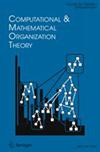Remembering Materiality: A Material–Relational Approach to Organizational Memory
IF 1.5
4区 管理学
Q3 COMPUTER SCIENCE, INTERDISCIPLINARY APPLICATIONS
Computational and Mathematical Organization Theory
Pub Date : 2021-07-01
DOI:10.1177/26317877211029666
引用次数: 6
Abstract
In this paper, we develop a material–relational approach to understanding organizational memory. We focus on the inherent materiality of mnemonic devices—material artifacts that anchor shared memories of the past. Mnemonic devices work to constitute social groups of organizational stakeholders bound together by mutual affinities to these devices, known as mnemonic communities. While we know that the materiality of mnemonic devices represents information about the past that is interpreted by members of the mnemonic community as a narrative that is important in the present, our approach focuses on how engagement with the material aspects of mnemonic devices can create relationships of affinity among people remembering together. To develop our conceptualization, we first apply insights from the literature on materiality and its emphasis on how materiality is the basis for non-verbal and relational communication. From this, we theorize four material attributes that affect how mnemonic devices constitute relational connections that create embodied, cartographic, and temporal boundaries for organizational mnemonic communities. We then conceptualize how these distinct material attributes accumulate, intersect, and interact with each other and with the narrative representations of mnemonic devices and how in turn these interactions may bind stakeholders together. By emphasizing the material–relational aspect of mnemonic devices, our paper theorizes a broader and potentially more powerful set of affinities between stakeholders and organizations and, on this basis, enhances extant research by articulating different paths to the emergence of mnemonic communities.记忆的重要性:组织记忆的物质-关系方法
在本文中,我们发展了一种材料关系的方法来理解组织记忆。我们关注的是记忆装置的内在物质性——锚定过去共同记忆的物质文物。助记器的作用是组成由组织利益相关者组成的社会群体,这些群体通过与这些设备的相互亲和力联系在一起,被称为助记器社区。虽然我们知道助记器的物质性代表了过去的信息,这些信息被助记器群体的成员解释为一种对现在很重要的叙述,但我们的方法侧重于如何与助记器的物质性方面接触,从而在一起记忆的人们之间建立亲密关系。为了发展我们的概念,我们首先应用文献中关于物质性的见解,并强调物质性如何成为非语言和关系沟通的基础。由此,我们理论化了四种物质属性,这些属性会影响助记器如何构成关系连接,从而为组织助记器社区创造具体的、地图的和时间的边界。然后,我们概念化这些不同的材料属性是如何累积、相交和相互作用的,以及如何与助记器的叙述表示相互作用,以及这些相互作用如何反过来将利益相关者联系在一起。通过强调助记器的物质关系方面,我们的论文理论化了利益相关者和组织之间更广泛、潜在更强大的一套亲和关系,并在此基础上,通过阐明助记器社区出现的不同途径,加强了现有的研究。
本文章由计算机程序翻译,如有差异,请以英文原文为准。
求助全文
约1分钟内获得全文
求助全文
来源期刊

Computational and Mathematical Organization Theory
COMPUTER SCIENCE, INTERDISCIPLINARY APPLICATIONS-MATHEMATICS, INTERDISCIPLINARY APPLICATIONS
CiteScore
3.80
自引率
16.70%
发文量
14
审稿时长
>12 weeks
期刊介绍:
Computational and Mathematical Organization Theory provides an international forum for interdisciplinary research that combines computation, organizations and society. The goal is to advance the state of science in formal reasoning, analysis, and system building drawing on and encouraging advances in areas at the confluence of social networks, artificial intelligence, complexity, machine learning, sociology, business, political science, economics, and operations research. The papers in this journal will lead to the development of newtheories that explain and predict the behaviour of complex adaptive systems, new computational models and technologies that are responsible to society, business, policy, and law, new methods for integrating data, computational models, analysis and visualization techniques.
Various types of papers and underlying research are welcome. Papers presenting, validating, or applying models and/or computational techniques, new algorithms, dynamic metrics for networks and complex systems and papers comparing, contrasting and docking computational models are strongly encouraged. Both applied and theoretical work is strongly encouraged. The editors encourage theoretical research on fundamental principles of social behaviour such as coordination, cooperation, evolution, and destabilization. The editors encourage applied research representing actual organizational or policy problems that can be addressed using computational tools. Work related to fundamental concepts, corporate, military or intelligence issues are welcome.
 求助内容:
求助内容: 应助结果提醒方式:
应助结果提醒方式:


